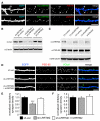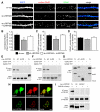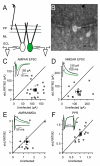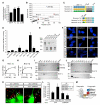LRRTM2 interacts with Neurexin1 and regulates excitatory synapse formation
- PMID: 20064388
- PMCID: PMC2829666
- DOI: 10.1016/j.neuron.2009.12.019
LRRTM2 interacts with Neurexin1 and regulates excitatory synapse formation
Abstract
We identify the leucine-rich repeat transmembrane protein LRRTM2 as a key regulator of excitatory synapse development and function. LRRTM2 localizes to excitatory synapses in transfected hippocampal neurons, and shRNA-mediated knockdown of LRRTM2 leads to a decrease in excitatory synapses without affecting inhibitory synapses. LRRTM2 interacts with PSD-95 and regulates surface expression of AMPA receptors, and lentivirus-mediated knockdown of LRRTM2 in vivo decreases the strength of evoked excitatory synaptic currents. Structure-function studies indicate that LRRTM2 induces presynaptic differentiation via the extracellular LRR domain. We identify Neurexin1 as a receptor for LRRTM2 based on affinity chromatography. LRRTM2 binds to both Neurexin 1alpha and Neurexin 1beta, and shRNA-mediated knockdown of Neurexin1 abrogates LRRTM2-induced presynaptic differentiation. These observations indicate that an LRRTM2-Neurexin1 interaction plays a critical role in regulating excitatory synapse development.
2009 Elsevier Inc. All rights reserved.
Figures




Similar articles
-
LRRTM2 functions as a neurexin ligand in promoting excitatory synapse formation.Neuron. 2009 Dec 24;64(6):791-8. doi: 10.1016/j.neuron.2009.12.012. Neuron. 2009. PMID: 20064387 Free PMC article.
-
Deletion of LRRTM1 and LRRTM2 in adult mice impairs basal AMPA receptor transmission and LTP in hippocampal CA1 pyramidal neurons.Proc Natl Acad Sci U S A. 2018 Jun 5;115(23):E5382-E5389. doi: 10.1073/pnas.1803280115. Epub 2018 May 21. Proc Natl Acad Sci U S A. 2018. PMID: 29784826 Free PMC article.
-
Leucine-rich repeat transmembrane proteins are essential for maintenance of long-term potentiation.Neuron. 2013 Aug 7;79(3):439-46. doi: 10.1016/j.neuron.2013.06.007. Neuron. 2013. PMID: 23931994 Free PMC article.
-
SynDIG1 regulation of excitatory synapse maturation.J Physiol. 2012 Jan 1;590(1):33-8. doi: 10.1113/jphysiol.2011.213884. Epub 2011 Aug 30. J Physiol. 2012. PMID: 21878521 Free PMC article. Review.
-
Promiscuous interactions between AMPA-Rs and MAGUKs.Neuron. 2006 Oct 19;52(2):222-4. doi: 10.1016/j.neuron.2006.10.002. Neuron. 2006. PMID: 17046684 Review.
Cited by
-
More than a pore: How voltage-gated calcium channels act on different levels of neuronal communication regulation.Channels (Austin). 2021 Dec;15(1):322-338. doi: 10.1080/19336950.2021.1900024. Channels (Austin). 2021. PMID: 34107849 Free PMC article. Review.
-
Diverging Effects of Adolescent Ethanol Exposure on Tripartite Synaptic Development across Prefrontal Cortex Subregions.Cells. 2022 Oct 2;11(19):3111. doi: 10.3390/cells11193111. Cells. 2022. PMID: 36231073 Free PMC article.
-
Uncovering Discrete Synaptic Proteomes to Understand Neurological Disorders.Proteomes. 2018 Jul 19;6(3):30. doi: 10.3390/proteomes6030030. Proteomes. 2018. PMID: 30029459 Free PMC article. Review.
-
AMPA receptors and their minions: auxiliary proteins in AMPA receptor trafficking.Cell Mol Life Sci. 2019 Jun;76(11):2133-2169. doi: 10.1007/s00018-019-03068-7. Epub 2019 Apr 1. Cell Mol Life Sci. 2019. PMID: 30937469 Free PMC article. Review.
-
Cartography of neurexin alternative splicing mapped by single-molecule long-read mRNA sequencing.Proc Natl Acad Sci U S A. 2014 Apr 1;111(13):E1291-9. doi: 10.1073/pnas.1403244111. Epub 2014 Mar 17. Proc Natl Acad Sci U S A. 2014. PMID: 24639501 Free PMC article.
References
-
- Biederer T, Scheiffele P. Mixed-culture assays for analyzing neuronal synapse formation. Nat. Protoc. 2007;2:670–676. PubMed. - PubMed
-
- Biederer T, Sara Y, Mozhayeva M, Atasoy D, Liu X, Kavalali ET, Südhof TC. SynCAM, a synaptic adhesion molecule that drives synapse assembly. Science. 2002;297:1525–1531. PubMed. - PubMed
-
- Chen L, Chetkovich DM, Petralia RS, Sweeney NT, Kawasaki Y, Wenthold RJ, Bredt DS, Nicoll RA. Stargazin regulates synaptic targeting of AMPA receptors by two distinct mechanisms. Nature. 2000;408:936–943. PubMed. - PubMed
Publication types
MeSH terms
Substances
Grants and funding
LinkOut - more resources
Full Text Sources
Other Literature Sources
Molecular Biology Databases

